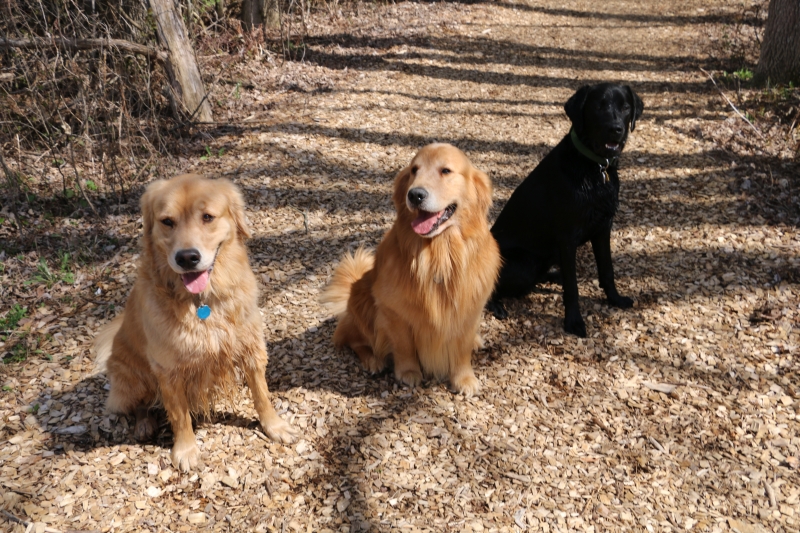
Outside of the Doghouse: Keeping Your Dog Safe and Healthy in Nature
Few activities bring more joy than watching dogs running around outside – leaping from rocks to logs, splashing in the water, and sniffing out nearby squirrels at the base of every tree they pass. It is impossible not to join, chasing them and throwing sticks for them to retrieve – their tongues hanging out of their smiling faces and tails wagging faster than the wings of a hummingbird. For thousands of years, dogs have remained our loyal and loving companions, and so there is nothing we want more than to keep our dogs healthy and happy.
With the unpredictable weather that we experience every year, you can never be too prepared when it comes to keeping your dog safe and healthy in the outdoors. I spoke with staff at the Canton Animal Clinic and the Canton Village Police Department about what owners should keep in mind when taking their dogs outside.
1. Know the Rules
There are a number of recreational areas and trails that allow dogs in St. Lawrence County, so it is important to be aware of local rules.
Leashes
Keep your dog close to you at all times, and remember that not all dogs are friendly around other dogs. Additionally, even if your dog is friendly, not everyone out walking is excited about being greeted by an energetic dog. Some people are not able to withstand a dog jumping up on them, especially young children, handicapped individuals or the elderly. It is important to keep your dog on leash on trails where leashes are required so that others have a sense of comfort and security.
Vaccines
Vaccines are now categorized as ‘core’ vaccines, which should be giving to every dog and ‘noncore’ vaccines which are recommended for certain dogs dependent on age, breed, health, and potential exposure to disease. ‘Core’ vaccines are necessary to prevent Canine Distemper, Parvovirus, Hepatitis, and Rabies, but if you spend time with your dog outside, it is recommended to vaccinate your dog for Lyme disease. Canine Journal provides more information about common diseases and vaccinations to prevent them, as well as a vaccination timetable.
2. Monitor the Weather
We are lucky to experience all four seasons here in the North Country. We feel the fresh, crisp fall air. We get to make snow angels when the ground is covered in a white, winter blanket. We can jump in puddles and smell spring flowers. And we enjoy the warm, summer sun. Our dogs enjoy the characteristics of all four seasons too, but the unique features of each season also mean that dog owners have different things to worry about at different times of the year.
Extreme Heat
Unlike humans, dogs don’t have sweat glands, except for on their feet, so they get rid of body heat by panting. But when temperatures are too high, panting alone is not enough to keep your dog cool. Make sure your dog is getting plenty of water throughout the day. Never leave your dog in the car, even if only for a few minutes. Some lighter colored dogs may be at risk for sunburn, so seek out areas with shade. Be aware of heat stroke, and limit rigorous exercise with your dog to cooler times during the day, like early mornings and evenings.
Extreme Cold
The same cold winters that characterize the North Country and create a population of hardy people can be risky for dogs. When the weather is below freezing, outdoor dogs often require extra calories to keep warm. Also, like people, dogs are susceptible to frost bite and should limit their time spent outside in temperatures 15 degrees Fahrenheit and below. And if temperatures drop below 10 degrees, vigorous activity, including running with your dog should be avoided all together because a dog’s lungs can freeze from panting.
If your dog spends a lot of time outside in the winter, it is critical that your dog has the appropriate shelter for keeping warm. Dry, well-insulated doghouses that are just large enough for your dog to stand up, turn around, and lie down are necessary. If the shelter is any larger, it becomes more difficult to retain heat. For additional warmth, you can use old blankets as bedding material because they are easy to remove and wash to keep dry and clean throughout the winter. If your dog is kept in a partially outdoor kennel, you can use tarps or burlap on a portion of the kennel for wind protection.
Other Winter Dangers
I am familiar with knee injuries when it comes to people recreating, but it surprised me to learn that it is not rare for a dog tear its ACL in the winter. Larger breeds may tear their ACL from slipping on ice or running in deep snow. Ice can also be a concern for older dogs that have stiff muscles and joints or arthritis.
Also note, a dog’s paw pads can be sensitive to street and sidewalk ice melters, like salt, magnesium and calcium chloride. These can also be toxic and cause upset stomachs if ingested. Wipe of your dog’s paws with a damp towel after walking on a salty area and check between its toes to make sure that snow hasn’t collected. Try using non-toxic ice melter, like Safe Paws, for your own driveway, or even go with sand or dirt to provide traction.
Antifreeze should be kept out of your dog’s reach at all times, as it is extremely poisonous, and even ingesting a few teaspoons can be lethal.
When going for walks outside, keep dogs away from bodies of water that may have thin ice, and off of snowmobile trails. Be aware of vehicles, skiers and other winter sport enthusiasts both for the safety of your dog and as a courtesy for people recreating outdoors.
3. Be Careful Around Water
Four rivers run through St. Lawrence County: the Grasse River, the Raquette River, the Oswegatchie River, and the St. Regis River. If you go swimming with your dog, avoid fast-moving water. All of these rivers have sections with rapids, and rivers move with greater force after a storm. Dogs have a hard time judging how strong a current is until they are in the water. Look for stiller segments that have shallow shorelines so your dog can easily get in and out of the water, and always keep an eye on it. If you have never taken your dog swimming before, try a still body of water, like a lake or pond, so your dog can practice. Not all dogs are strong swimmers.
4. Prevent Scavenging
Dogs are usually the first to find anything that we would want to avoid in the woods. Keep dogs leashed or near you when walking so you can prevent them from consuming dangerous material they might find in the woods.
Animal remains and rotting carcasses are common discoveries, but you want to make sure you keep your dog from scavenging around an animal carcass because it can cause pancreatitis. The pancreas is integral in digesting foods, and acute pancreatitis can be unpredictable and life threatening. More information about pancreatitis in dogs can be found here.
You also want to avoid allowing your dog to scavenge in feces, especially those of another dog or animal. Feces can be the host of a number of different bacteria and can cause disease and worms. Parvovirus is a highly contagious intestinal virus that can be transmitted by any person, animal or object that comes into contact with an infected dog’s feces. It can cause lifelong cardiac problems when transmitted to puppies, and it can be fatal. The virus can survive for months of inanimate objects, like shoes and toys, so it is important to keep all areas clear of animal feces.
Toxic Plants
The ASPCA provides an extensive list of plants toxic to dogs. The list includes some wild species that are not common to the North Country. However if you are unsure of a plant in your yard, this is a great list to refer to. The Canton Animal Clinic highlighted onions, grapes and lilies, but also keep in mind that apple seeds, daffodil bulbs, and potato shoots and sprouts are toxic as well.
Also, keep in mind common plants that we tend to avoid ourselves, like poison ivy and poison oak. Though neither plant will affect your dog, the oils from the plant can be transferred from your pet’s coat to you. So if you notice your dog getting into some poison ivy, it would be a good idea to give it a nice bath to wash off the toxic oils.
5. Be Aware of Insects and Other Animals
Ticks are probably the most well known threat for your dog, as they can be carriers of Lyme disease, and it is important to regularly check your dog when it plays outside, especially when in the woods. Fortunately, poisonous snakes, spiders, and toads are rarely a problem in the North Country. But bees may and other insects may send your dog to veterinarian. A dog may stick its nose into an anthill, which could result in numerous painful bites. Bee stings are usually not fatal, but it is crucial to avoid numerous bee stings, which could require a trip to the vet and a dose of antihistamine. A simple way to avoid anthills and bee hives is to keep your dog on a leash when walking in the woods, but if your dog spends time outside unleashed, it is important to keep an eye out for possible insect threats in your backyard. And make sure you are checking your dog every time it goes outside so that you can immediately take care of any bites or stings.
As for some larger animals that may come into contact with dogs, raccoons are the most commonly reported rabid animals, and even if your dog’s vaccines are up to date, it is important to go to the vet immediately after a bite. Coyotes tend to live where there are people, and are attracted by garbage and compost piles. Keep coyotes out of your property by securing trash, closing up gaps under porches and sheds, and latching any gates in a fence. When out walking, you can help your dog avoid wild animals by keeping it leashed or close to you in recall range.
There is no question that dogs are the most faithful companions. They give unconditional love and expect little in return. The bond between (wo)man’s best friend is unmatched. No greater joy comes from watching your playful pal’s wagging tail, so it is important to give your dog the best care possible. As we move into summer, spend some time outside with your dog, but keep in mind these tips for keeping it healthy and happy.

